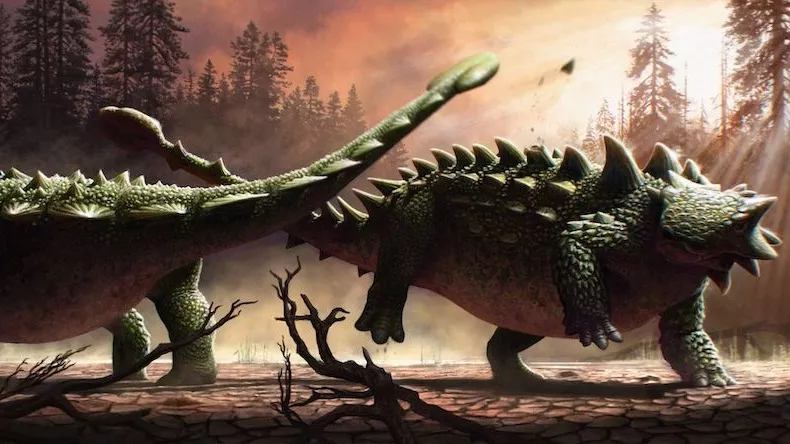Ankylosaurs were dinosaurs that lived during the Jurassic and Cretaceous periods. They were plant-eaters and had bodies that were covered in bony plates and spikes for defense. Some species had large tails that may have been used as weapons. These dinosaurs were not very agile and likely relied on their armor for protection from predators.
A study published in the journal Biology Letters has shown that ankylosaurs, which were previously thought to only use their tail clubs to defend against predators, also used them to assert dominance over each other.
To conduct their investigation, a team of North American paleontologists examined Zuul crurivastator, a well-preserved ankylosaur fossil on display at the Royal Ontario Museum in Toronto, Canada. The species name, crurivastator, means "destroyer of shins" in Latin and refers to the formidable club at the end of the dinosaur's 10-foot-long tail.
Ankylosaurus' Fossilized Specimen
The fossilized skin preservation over the damaged bony plates impressed David Evans, the co-author of the study and Temerty Chair and curator of vertebrate paleontology at ROM. In an email to Live Science, he said that seeing the healing reflected in the soft tissue is something really special about Zuul.
He then added that the fossilized skin preserved over the entire body of Zuul allowed for a detailed picture of what the animal looked like when it was alive. The location of the damaged armor relative to the undamaged armor allowed for the study of the pattern of pathology across the entire body. Scientists have long believed that ankylosaurs used their tails as a "sledgehammer" to fend off predators, including Tyrannosaurus rex.
However, the injuries inflicted on the fossilized ankylosaur, named Zuul, suggest that the tail may have also been used for sexual selection, similar to the way deer use antlers and antelopes use horns. The study researchers said that this discovery adds another "piece to the puzzle" and suggests that ankylosaurs may have been more socially complex than previously thought, possibly engaging in battles with other members of their species for dominance or to impress mates.

ALSO READ: Armored Dinosaur with Heavy Tail That Looks Like Stegosaurus and Ankylosaurus Unearthed in Chile
Armored Bodies with Different Purposes
Evans added that the discovery of possible jousting among ankylosaurs "transforms them from the dinosaurian battle tanks to the dinosaurian knights in shining armor." This suggests that ankylosaurs may have been more than just sluggish animals, but may have engaged in complex social behavior and even combat with each other.
In a released study from the Canadian Journal of Earth Sciences, Ankylosaurus was defined as a heavily armored dinosaur that lived during the late Cretaceous Period, about 65.5 million to 66.8 million years ago. It was named "fused lizard" in Greek because of the fused bones in its skull and other parts of its body, which made it extremely rugged. Ankylosaurus was a herbivore and roamed the Western United States and Alberta, Canada.
It was a massive animal, with the largest specimen ever found measuring 20.5 feet long, 5.6 feet tall at the hips, and 4.9 feet wide. It likely weighed up to 4 tons. The top of the dinosaur was almost completely covered with thick armor consisting of massive knobs and oval plates of bone, known as osteoderms or scutes, which are also found on crocodiles, armadillos, and some lizards.
Check out more news and information on Ankylosaurus in Science Times.












